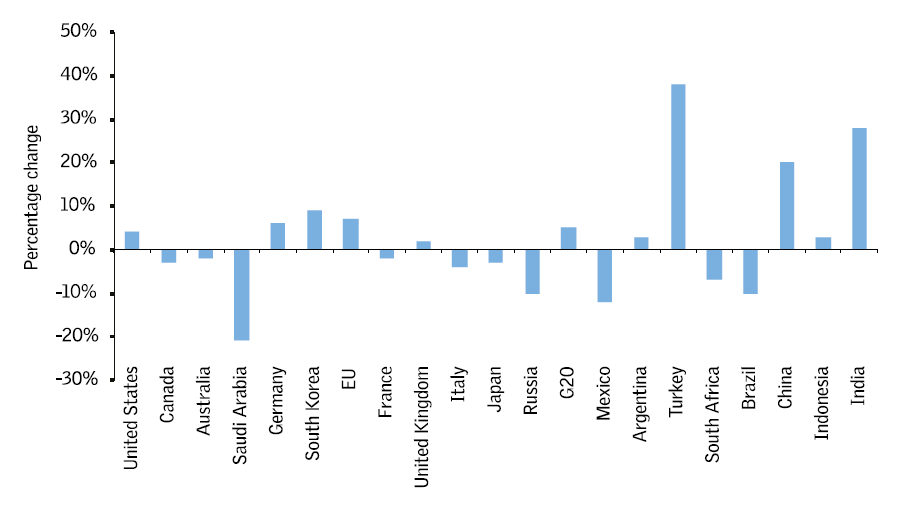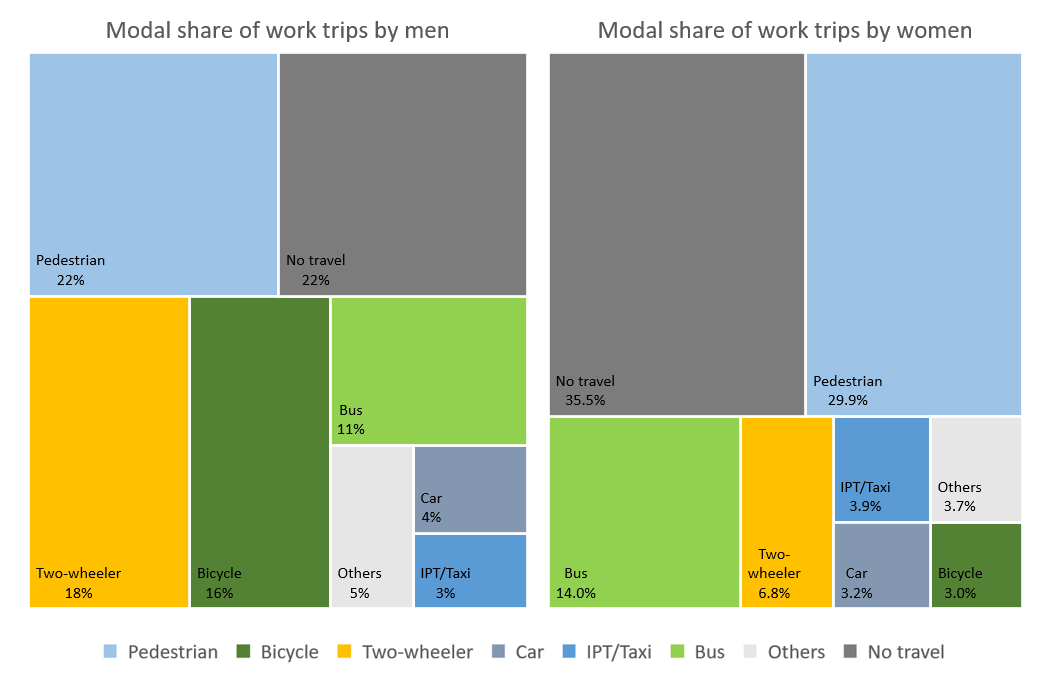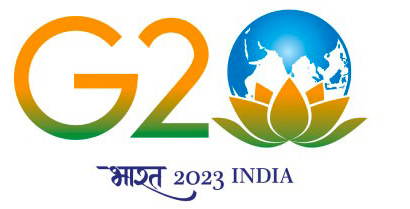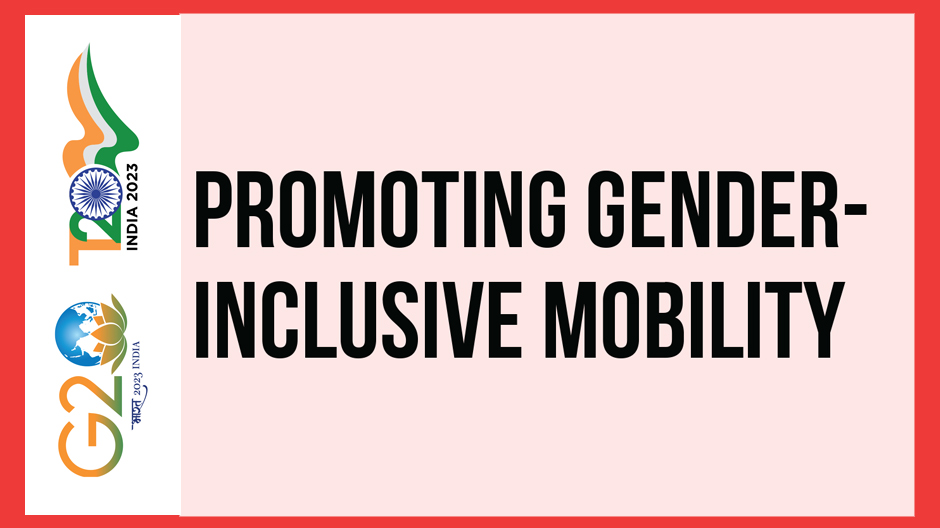Task Force 6: Accelerating SDGs: Exploring New Pathways to the 2030 Agenda
The provision of accessible urban transport solutions facilitates opportunities, including obtaining education and participating in economic activities. Yet, historically, urban transport planning has overlooked women’s mobility needs. The failure of mobility systems to respond to gender-based evidence poses challenges and places constraints on women because of their greater dependence on public transport. Therefore, India, through the G20, should recognise women’s mobility requirements and engage them in decision-making processes to achieve gender-inclusive policy formulation. This will provide a sound basis for attaining the Sustainable Development Goals (SDGs), especially SDG 11.2, which aims to provide access to safe, affordable, accessible, and sustainable transport systems. The G20 can play an important role to ensure that public transport systems and last-mile connectivity are designed and implemented with gender equity in mind, creating equitable and sustainable transport systems for all.
1. The Challenge
The Synthesis Report 2023 for the Intergovernmental Panel on Climate Change (IPCC) Sixth Assessment Report (AR6) provided a decadal window to either halve the global greenhouse gas (GHG) emissions or face dire consequences of temperatures rising beyond 1.5°C. The effects on developing nations and emerging economies, such as India, could worsen unless policymakers, industry, civil society, and individuals act together to accelerate decarbonisation. However, over the years, demand for both passenger and freight mobility has increased with India’s rapid economic growth.[1] With 13.5 percent of the total carbon emissions, transport is the third highest emitting sector in India;[2] road transport contributes 90 percent of these emissions.[3] On comparing the per capita emissions from the sector, it was found that India’s emissions amounted to 0.22 tCO2e/year in 2018, substantially lower than the G20 average of 1.13 tCO2e/year. However, the growth in the per capita emissions of transport is estimated to be 28 percent—one of the highest rates in the G20 countries,3 as shown in Figure 1.
Figure 1: Per Capita Growth Rate of Transport GHG Emissions in the G20 Countries3

Source: Centre for Science and Environment 2021
Urban mobility is a key factor that allows citizens to access economic and social opportunities, and gender is a key sociodemographic variable that influences travel behaviour but is often the least understood. Despite women forming a significant user group of public transport, there is not enough disaggregated analyses of mobility patterns at the city level in India. Various studies show that women are more likely to consider the affordability of a transport mode and use low-carbon emitting modes, such as public transport and walking. However, government-provided public transport services in the form of bus- and rail-based transport are present in only 65 cities in India.[4]
It is widely believed that urban mobility demands can be met by private vehicles; this gets reflected in car-centric transport planning. Urban streets, originally planned as public spaces for all road users, have been progressively claimed by motorised traffic, with 27 percent of private motor vehicle trips occupying 75 percent of the right-of-way while pedestrian trips account for a quarter to a third of all trips.[5] Even in cities, where public transport is available, services are often inadequate and unreliable, and lack service quality. Additionally, even with cities’ high dependence on walking and non-motorised transport or intermediate public transport, most have inadequate infrastructure. Thus, improvement in the infrastructure of the public transportation systems in India will ensure that women’s mobility needs are met, along with safety and security.
1.1 Institutional framework with a focus on road transport
Previous and current policies, such as master plans and comprehensive mobility plans, have aimed at road-based motorised transport. National policies on transport (Figure 2) and city mobility plans for 11 cities were looked at to identify the keywords pertaining to urban mobility. Keywords such as ‘road’, ‘speed’, ‘vehicle’, ‘parking’, and ‘flyover’, indicate the dominant interventions made for private motorised trips. The mentions of ‘public transport’, ‘pedestrians’, ‘cycles’, ‘buses’, ‘bus rapid transport (BRT)’, and ‘metro’—which could point towards providing a network of public transport—are less frequent. Even in plans concentrating on public transport and non-motorised transport, the nuances of the effects on vulnerable groups, such as women, transgender persons, and those with disabilities, are missing. These plans hardly focus on providing safe, equitable, inclusive, and accessible mobility for all, and instead they dwell on expansion of road network and providing seamless traffic flow to motorised vehicles.
Cities have historically been planned and designed to reflect traditional gender roles and gendered division of labour. Women are often underrepresented in transport planning institutions and service providers, and thereby are excluded from decision-making.
Figure 2: Transport Policies at the National Level

Source: Author’s own
1.2 Skewed modal share for public transport
A gendered comparison of the 2011 Census data revealed that. 31 percent of women accessed their workplaces on foot, compared with 28 percent of men.[6] Furthermore, for work trips, 15 percent of women used bus-based public transport, compared with 14 percent of men.7 Only 10 percent of women use motorised two-wheelers and cars, whereas 22 percent of men use motorised vehicles, as shown in Figure 3. Only few gender-based disaggregated analyses of mobility patterns at the city level in India are available and not collated frequently by institutions for decision-making with regard to national-/state-/city-level mobility plans. Therefore, this leads to women’s mobility needs getting overlooked and affects their safety and security in the public transport systems of India.
Figure 3: Modal Share of Work Trips in Urban India7

Source: Tiwari and Nishant 2018
1.3 Difference in travel requirements
Through literature based on travel patterns in India, differences in mobility between women and men have been highlighted, such as with regard to the distance travelled, travel needs depending on their responsibilities for childcare, domestic work and caregiving, diversity in trip patterns and stops, vulnerability to harassment, and concern for personal security in public transportation (Table 1).
Table 1: Travel Patterns of Women and Men in India
| Women | Men |
| Use public transportation and non-motorised transport (NMT) as main transport modes | Have access to personal motorised transport |
| Undertake chained and short trips | Travel point to point from home to workplace |
| Value flexibility, convenience, and safety | Consider time-saving transport modes |
| Travel shorter distances and in limited geographical area | Travel longer distances |
| Engage in more non-work-related travel | Travel mostly for paid work activities |
| Travel with dependents in off-peak hours | Travel solo during peak hours |
| Pay additional travel costs for trip chaining, safety, and other reasons | Spend less on transport |
Source: Ollivier, Nikore, and Natasha, ‘Toolkit’, 2022.
These differences create difficulties for women while accessing public transport; it entails substantial hidden costs in terms of time and money, and women’s participation in society[7] as, historically, cities have been planned to fit the transport needs of able-bodied male users instead of catering to the requirements of all.[8] Consequently, women and other gender minorities find their access to employment, education, healthcare, leisure, and public spaces constrained.
1.4 Limited focus on non-motorised transport
Thirty percent of women who commute to work are pedestrians, and three percent are cyclists; even for up to 6-10 km of the trip length, 35 percent of women are pedestrians.7 However, parents with children (mostly women) and people with physical restrictions in mobility face issues of high kerbs, missing footpaths, poorly lit streets, and short time spans of pedestrian signals. Even constructed footpaths are usually dug up, end abruptly at property entrances, are obstructed by placement of such public utilities as bus shelters and signages, and have uncomfortable heights[a] and parking encroachments, which have become common in urban areas. Thus, walking and cycling infrastructure, which should complement the public transport systems especially for first- and last-mile connectivity, is missing in cities.
1.5 Security and comfort in public transport
A study by Safetipin[9] showed a peak around 12-2 pm with regard to harassment of women. This indicates that the traditional safety measure of lighting is not the only security step required. Similarly, women do not consider CCTV cameras as a security measure as these only help after an incident has occurred.
With less frequent public transport during off-peak hours, when the majority of commuters are women, with trip chaining, the waiting time at the stops increases. Higher wait time at public transit stops increases the anxiety of a commuter. The ad hoc manner of planning the frequency and timings of women-only buses also needs to be scrutinised. Absence of restrooms or toilets along the public transit system and isolated or deserted public places also fuel discomfort.8 Eyes on the street, natural surveillance beyond CCTVs, and proper streetlights can reduce the number of dark spots.
The design of transport infrastructure, including 0.23-0.3-metre high stairs for onboarding and alighting buses, position of hand loops for standing passengers and panic buttons in public transport, cleanliness of public transport and areas around stops, and limited seating space at transit stops need to be examined.
1.6 Financial constraints at the city level
Urban planning, including town planning, roads and bridges, and public amenities, including streetlighting, parking lots, bus stops, and public conveniences, are functions listed for municipalities in the 12th Schedule of Indian Constitution. However, these functions are mostly with state government parastatals and not devolved to municipalities. The state expenditure on transport primarily focuses on road widening or road beautification projects, streetlights, and CCTVs, without any participatory approach. However, the municipalities can augment the transport services and related infrastructure in a better manner with capacity-building.
2. The G20’s Role
The G20, in the context of the policy challenges identified, can create viable opportunities for transparency and collaboration among the member nations, with the first step of disaggregating data for different groups and being sensitive to gender concerns. The G20 countries should follow the New Urban Agenda, which promotes safe access and age- and gender-responsive, affordable, and sustainable urban mobility by enabling meaningful participation in social and economic activities in cities.[10] The G20 can create a knowledge-sharing platform for disseminating the best-case examples in the respective countries.
Under the Urban20 forum, it can discuss successful urban pilot projects on clean streets or low emission zones with mandatory inclusion of women’s perspective. The deliberations should cover the replicability of these projects in other countries with similar travel patterns and focus on data as the fundamental block for the shift to public transport strategy. With the aid of G20 countries’ funding mechanisms, scalability of the successful pilot projects on public transport systems can be explored. Under Urban20, the countries can deliberate on the implementation of gender-inclusive transport policies on a global scale; it is essential to design and build safe and sustainable transport infrastructure, and to minimise vulnerability to climate change.
3. Recommendations to the G20
Gender must be considered in all stages of the planning process—data collection, planning and design, implementation, and monitoring. Within the categorisation of gender, characteristics such as age, income, race, ethnicity, and composition of households, should also be captured. Crucial issues, such as supporting women’s participation in decision-making, improvements in accessibility, safety, and comfort, and planning gender-friendly transport services—need to be addressed.
Figure 4: Framework for Gender-Sensitive Transport Systems

Source: Adapted from She RISES: A Framework for Caring Cities, Safetipin, 2022
3.1 Public transport
Area-level planning by public transport service providers along the transit nodes within the 500-metre radii and multimodal integration, will guarantee smooth travel for chained trips. The infrastructure and frequency of transit should be improved in the public transportation system. The frequency and reliability of services, particularly at night and on weekends, should be improved to reduce waiting time and provide convenient and safe commute outside of peak hours. Women’s organisations in the private sector should be included in the development of gender-sensitive policies and gender budgetary allocations should be made for public transportation infrastructure at city and state levels with more representation at the authority level.
3.2 Pedestrian facilities
Authorities should create wider footpaths, with a minimum clear width of 1.80 metres,[b] along with ramps for smooth access to and exit from properties. In neighbourhood streets, separate spaces for vending and resting, and street amenities should be made available. Separate streetlights at the pedestrian scale must be provided.[c] For safe, easy, and affordable mobility, access to public transportation services and areas should be devoid of restrictions and impediments. Prohibition of unauthorised parking and two-wheelers on sidewalks should be enforced strictly by transport department officials. Designs for commuter seating, with regular increments in seat heights, in public transportation shelters, should offer basic comforts, such as shading, public amenities, such as drinking water, and real-time information on forthcoming transportation.
The government can employ the private sector for creation of infrastructure, which should ensure comfort, based on inputs from users; gender-sensitive restrooms with sanitary napkin vending and menstrual waste disposal units must be built. Bathrooms and entrances should have separate entry points for men and women. Regular maintenance of public spaces will ensure continued usage by everyone.
3.3 Safety and security
Women and other sections of the population who face unique challenges in mobility will feel more secure if the government ensures that more women employees are working as drivers or conductors, and are posted at transit nodes. By building infrastructure with a secure working environment, this can be possible. A better travel experience will also be provided by clean and hygienic physical environments with visible signages at transportation hubs and inside transportation systems. Women constables should be present in areas that are not well-lit to ensure security and check harassment, similar to how the Railways’ dedicated team of women Railway Protection Force (RPF) constables carry out their responsibilities.
The central command control stations should record CCTV footage when the panic buttons are pressed so that it can be used as proof when harassment is reported; utilisation of such footage will ensure a sense of security. In case of an incident, the staff should take immediate action, such as taking the bus concerned to the nearest police station. The transport staff and police personnel should be proficient in the standard operating procedures to follow in such cases.
It is possible to implement intermediate security measures for exclusive women’s transportation options, such as free travel for women, all-women special suburban trains, and reserved ladies’ coaches on suburban and metro trains. Civil society organisations should form self-help groups, comprising regular commuters; regular meetings with service providers should be held to apprise the operators of their issues.
3.4 Use of technology
Technological tools can be used to plan, respond, and deal with the short- and long-term repercussions of a disaster to ensure the climate resilience of transportation services. The G20 countries can exchange the latest technologies in the transport sector to enable development for all. Assessing the effects on women and improving accountability of operators and policymakers will be made easier with continuous evaluation and monitoring of the initiatives and programmes for women commuters. Gender-disaggregated data on travel patterns of different groups should translate to policymaking. During operations at public transportation stops, live information of arrival of buses and ride-sharing services through mobile applications can help reduce waiting time at public transport nodes; this will improve trip chaining and multimodal integration.
Efficient complaint redressal mechanisms, using mobile applications, should eliminate tedious and long procedures at police stations; this will help in timely redressal. Implementing gender sensitisation and capacity-building initiatives for drivers and other public transport staff should be mandatory. It is important to raise public awareness through traditional and social media to sensitise the general public to proper etiquette to be maintained while using public transportation and first- and last-mile transport services. While laws to address sexual harassment exist, awareness and implementation of these need to be strengthened.
3.5 Multistakeholder participation
Intersections among metropolitan development plans, master plans, city mobility plans, and climate action plans should be prepared holistically, in collaboration with stakeholders and citizens, and should be institutionalised in upstream urban planning processes. Participatory methods through civil society organisations derive learnings from community knowledge and experience; these should be driven by locally identified priorities with equal emphasis on women and gender minorities, involved from the research stage, and should be facilitated by gender-disaggregated data collection.
There should be collaborative action on the part of street planning authorities, public transport service providers, and enforcement agencies for seamless travel. Smooth trip chaining with predictable frequency should also be possible. The earmarked budget for public transport should be utilised in association with multiple agencies.
Citywide communication campaigns, with the help of the private sector, on women’s safety should be conducted to increase civic awareness about respect for women and their safety. These campaigns should encourage women to report harassment and bystanders to assist women, and can be initiated by local non-governmental organisations. Deep-seated patriarchal attitudes and norms should be changed.
3.6 Low-carbon zones
Low-carbon zones aim to restrict polluting vehicles in a designated area to improve air quality. Ideally, these encourage sustainable transport and promote improved liveability.[11] These priority zones with stringent measures of speed control, low-emission vehicles, and thermal comfort with greening should be established around public transportation stops to promote more active spaces around these stops. By redesigning community streets, interoperable with transport infrastructure for public transport, walking, and cycling, safer street interactions for all users, including women, should be prioritised.
3.7 Tactical urbanism
As a tool for public participation, tactical urbanism will be a rapid, affordable, and temporary intervention to improve public places and neighbourhoods. Public areas and transportation will seamlessly interconnect with inputs from interactions with various groups. Implementing measures through tactical urbanism to slow vehicular traffic, with reduced vehicle lanes, raised crosswalks, and increased lane width for bicycles and walking, will ensure safer streets. More public open spaces for interaction, such as central plazas surrounded by daytime activity to provide eyes on the street, a community market, and transit stops close to these public places, should be encouraged.
Attribution: Akshaya Paul, “Promoting Gender-Inclusive Mobility,” T20 Policy Brief, July 2023.
Endnotes
[a] Optimum height of footpaths should be 0.15 metre, as prescribed by the Indian Road Congress (IRC).
[b] Minimum clear width for two wheelchairs to pass without obstruction
[c] IRC103:2012 Guidelines for Pedestrian Facilities and UTTIPEC street design guidelines must be followed.
[1] Gaurav Bansal, and Anup Bandivadekar, “Overview of India’s vehicle emissions control program: Past successes and future prospects”, International Council on Clean Transportation 2013.
[2] TERI, “Decarbonization of Transport Sector in India: Present Status and Future Pathways”, The Energy and Resources Institute, 2021.
[3] Centre for Science and Environment, “Greenhouse gas emissions by Indian transportation sector ON THE ROAD TO COP 26: Discussion Paper Series India’s Climate Change Strategy”, Centre for Science and Environment , 2021.
[4] Megha Kumar, Seema Singh, Akshima T. Ghate, Sarbojit Pal, and Sangeetha Ann Wilson, “Informal public transport modes in India: A case study of five city regions,” IATSS Research, Vol.39(2), (2016) :102-109.
[5] Institute for Transportation and Development Policy, “Complete Streets Policy Network”, Institute for Transportation and Development Policy (ITDP) and Ministry of Housing and Urban Affairs (MoHUA), 2019.
[6] Nishant Singh and Geetam Tiwari, “Travel to Work in India: Current Patterns and Future Concerns”, Transport Research & Injury Prevention Programme, Indian Institute of Technology Delhi, , 2018.
[7] Gerald Ollivier, Mitali Nikore, and Sarah Natasha, “Toolkit for Enabling Gender Responsive Urban Mobility and Public Spaces India; Volume I: The ‘What-To-Do’ Note for Policymakers”, World Bank, 2022.
[8] Ankita Kapoor, “Women and Mobility: A Case Study of Bhopal, Gwalior & Jodhpur”, Safetipin, 2020.
[9] Surabhi T Mehrotra, , Kalpana Viswanath, Ankita Kapoor and Rwitee Mandal, “She RISES (Responsive, Inclusive, Safe & Equitable Cities)”, Safetipin, 2022.
[10] United Nations, “New Urban Agenda”, United Nations, 2017.
[11]Dana Yanocha, Yeojin Kim, and Jacob Mason, “The Opportunity of Low Emission Zones: A Taming Traffic Deep Dive Report”, Institute for Transportation & Development Policy, 2023.





